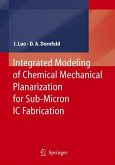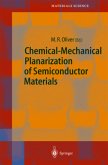This book is the product of a developing research focus on CMP at Berkeley. Its focus is on the important area of process models which have not kept pace with the tremendous expansion of applications of CMP. It specifically deals with the development of models with sufficient detail to allow the evaluation and tradeoff of process inputs and parameters to assess impact on quality or quantity of production. The important role of the mechanical elements of the process are included in such an "integrated model". The objective of the book is to introduce some background on the overlooked mechanical aspects of the process - including pad surface topography and abrasive particles. The "integrated model" can be particularly useful as one looks towards optimization of the process, design of consumables and, importantly, looking to minimize the environmental affects of CMP.
Chemical mechanical planarization, or chemical mechanical polishing as it is simultaneously referred to, has emerged as one of the critical processes in semiconductor manufacturing and in the production of other related products and devices, MEMS for example. Since its introduction some 15+ years ago CMP, as it is commonly called, has moved steadily into new and challenging areas of semiconductor fabrication. Demands on it for consistent, efficient and cost-effective processing have been steady. This has continued in the face of steadily decreasing feature sizes, impressive increases in wafer size and a continuing array of new materials used in devices today. There are a number of excellent existing references and monographs on CMP in circulation and we defer to them for detailed background information. They are cited in the text. Our focus here is on the important area of process mod els which have not kept pace with the tremendous expansion of applications of CMP. Preston's equation is a valuable start but represents none of the subtleties of the process. Specifically, we refer to the development of models with sufficient detail to allow the evaluation and tradeoff of process inputs and parameters to assess impact on quality or quantity of production. We call that an "integrated model" and, more specifically, we include the important role of the mechanical elements of the process.
Chemical mechanical planarization, or chemical mechanical polishing as it is simultaneously referred to, has emerged as one of the critical processes in semiconductor manufacturing and in the production of other related products and devices, MEMS for example. Since its introduction some 15+ years ago CMP, as it is commonly called, has moved steadily into new and challenging areas of semiconductor fabrication. Demands on it for consistent, efficient and cost-effective processing have been steady. This has continued in the face of steadily decreasing feature sizes, impressive increases in wafer size and a continuing array of new materials used in devices today. There are a number of excellent existing references and monographs on CMP in circulation and we defer to them for detailed background information. They are cited in the text. Our focus here is on the important area of process mod els which have not kept pace with the tremendous expansion of applications of CMP. Preston's equation is a valuable start but represents none of the subtleties of the process. Specifically, we refer to the development of models with sufficient detail to allow the evaluation and tradeoff of process inputs and parameters to assess impact on quality or quantity of production. We call that an "integrated model" and, more specifically, we include the important role of the mechanical elements of the process.








